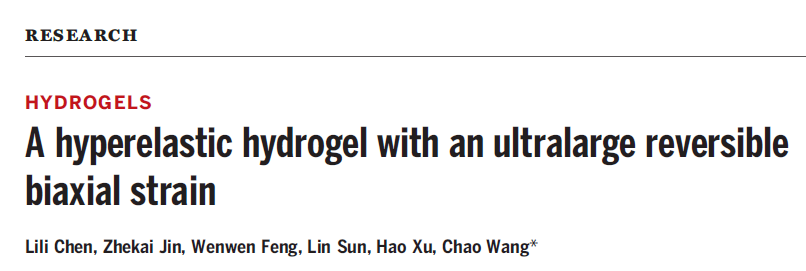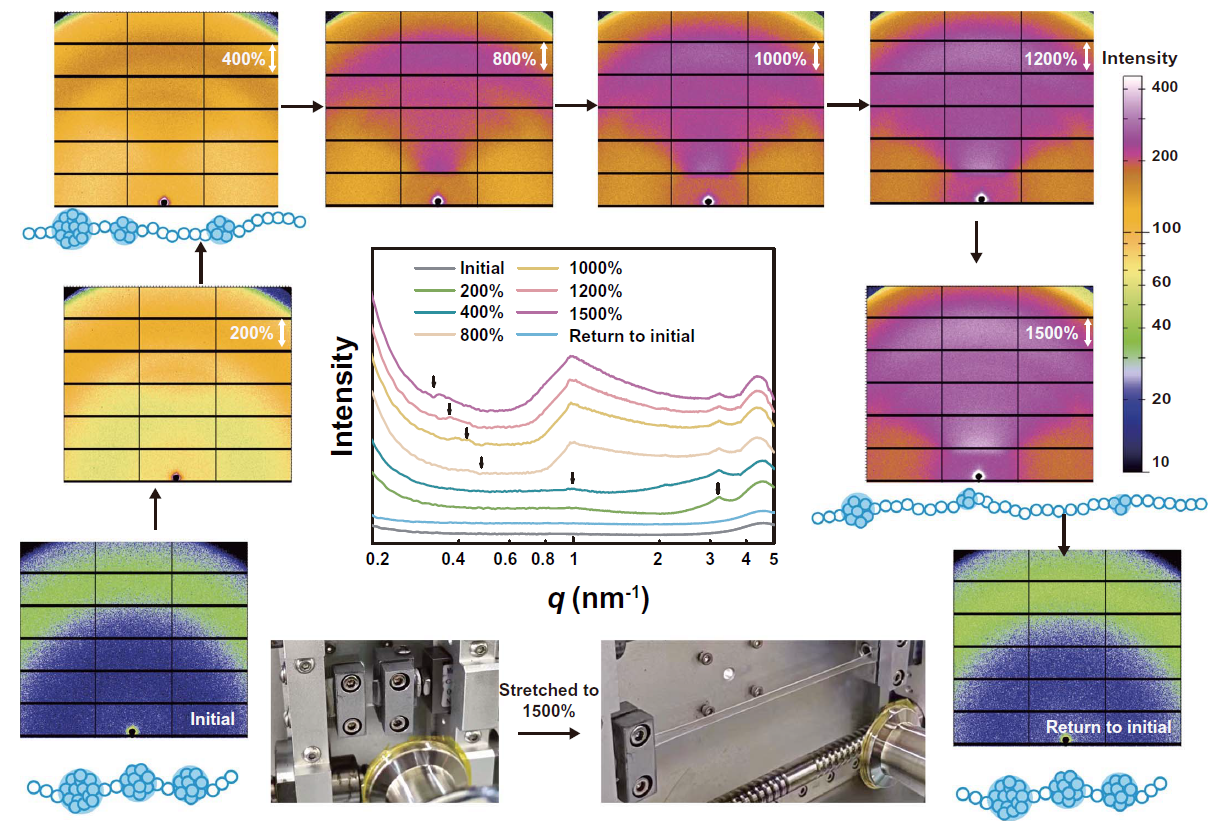Existing polymer network model of hydrogels approximately adopts phantom network model or slip-link model. Maximum uniaxial elastic deformation (lmax) follows an exponent of 1/2 with respect to N in existing hydrogels. Biaxial deformation is more challenging because chains extend along two directions. Covalent cross-links or unfixed slide-ring cross-links greatly limit the stretchability because of biaxial deformation locking. The reversible biaxial areal strain in existing hydrogels is, at present, limited to less than 2500%. Professor Chao Wang group in Tsinghua University first proposed a brand-new pearl-necklace network model, the lmax of which is close to 2/3. Through Shanghai Synchrotron Radiation SAXS tests, the authors witnessed the existence and reversible unfolding and refolding of pearl-necklace chains (PNCs). Hydrogels with reversible PNCs can offer an ultralarge reversible biaxial strain. This work published in Science titled with “A hyperelastic hydrogel with an ultralarge reversible biaxial strain”.

Polyelectrolytes have both hydrophobic groups and charged groups. Electrostatic repulsive interactions between charged groups force polymer chain to extend; hydrophobic interactions between hydrophobic groups cause polymer chains to collapse. The competition and balance of hydrophobic and electrostatic interactions led to the formation of PNC structure. However, in the past, PNCs were only proposed in dilute solutions. The authors first propose a brand-new pearl-necklace network through heterogeneous hydration of flexible and weakly hydrophobic polyelectrolytes in water-scarce conditions. To observe the PNC structure, the authors conducted AFM tests, The AFM height and phase images showed PNC structures did exist under water scare conditions. Cryo-TEM images furthermore verify the existence of PNCs in hydrogel networks, the image shows that the hydrogel is full of sub-nanometric beads. SAXS data showed the average distance between beads is 1.39 nm.
Figure 1 Pearl-necklace network
The authors in-situ observed the unfolding and refolding process of beads using Synchrotron radiation SAXS tests. With an increase of the applied strain, new circular scattering rings appeared in the 2D SAXS images, which showed larger distances between beads. The information gathered from the SAXS peaks aligned well with the theoretical values corresponding to the applied strains. At a low applied strain (200%), the initially randomly oriented PNCs gradually aligned along the applied force, with only a few polymer strands pulled out of the beads. Thus, the distances between beads changed little, causing the calculated strain (42%) to deviate from the applied strain (200%). With a larger stretch, a substantial number of polymer strands were drawn out of the beads, resulting in less deviation from the applied strain. The SAXS data of the hydrogel recovering from 1500% closely resembled that of the undeformed hydrogel, which show PNCs can recover completely upon release from 1500%.

Figure 2 Reversible pearl-necklace chain
The hydrogel demonstrates a broader elastic range compared with that of traditional hydrogels, owing to the efficient unfolding and refolding of subnanometric beads under cyclic mechanical strains, and exhibits notable properties, such as rapid recovery after extreme biaxial stretching (a reversible areal strain of 10,000%). A cuboid pneumatic device with a 0.54-ml cavity made of AETC-25 hydrogels expanded to about 1000 times its original volume when inflated with air and then rapidly recovered upon deflation.
Figure 3 Hyperelasticity




